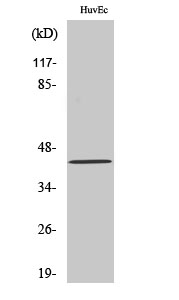HNK-1ST Polyclonal Antibody
- 产品详情
- 实验流程
- 背景知识
Application
| WB, IHC-P |
|---|---|
| Primary Accession | O43529 |
| Reactivity | Human, Mouse, Rat |
| Host | Rabbit |
| Clonality | Polyclonal |
| Calculated MW | 42207 Da |
| Gene ID | 9486 |
|---|---|
| Other Names | CHST10; Carbohydrate sulfotransferase 10; HNK-1 sulfotransferase; HNK-1ST; HNK1ST; HuHNK-1ST |
| Dilution | WB~~Western Blot: 1/500 - 1/2000. Immunohistochemistry: 1/100 - 1/300. ELISA: 1/40000. Not yet tested in other applications. IHC-P~~N/A |
| Format | Liquid in PBS containing 50% glycerol, 0.5% BSA and 0.09% (W/V) sodium azide. |
| Storage Conditions | -20℃ |
| Name | CHST10 {ECO:0000303|PubMed:23269668, ECO:0000312|HGNC:HGNC:19650} |
|---|---|
| Function | Catalyzes the transfer of sulfate from 3'-phosphoadenylyl sulfate (PAPS) to position 3 of terminal glucuronic acid of both protein- and lipid-linked oligosaccharides. Participates in biosynthesis of HNK-1 carbohydrate structure 3-O-sulfo-beta-D-GlcA- (1->3)-beta-D-Gal-(1->4)-D-GlcNAc-R, a sulfated glucuronyl-lactosaminyl residue carried by many neural recognition molecules, which is involved in cell interactions during ontogenetic development and in synaptic plasticity in the adult. May be indirectly involved in synapse plasticity of the hippocampus, via its role in HNK-1 biosynthesis (PubMed:9478973). Sulfates terminal glucuronyl residue of the laminin globular (LG)-domain binding epitope on DAG1/alpha-dystroglycan and prevents further polymerization by LARGE1 glycosyltransferase. Likely defines the chain length of LG epitope, conferring binding specificity to extracellular matrix components (PubMed:32149355). Plays a role in down-regulating the steroid hormones. Sulfates glucuronidated estrogens and androgens with an impact in hormone cycle and fertility. Has a preference for glucuronyl moiety at the 3-hydroxyl group of a sterol ring rather than the 17-hydroxyl group, showing high catalytic efficiency for 17beta-estradiol 3-O-(beta-D-glucuronate) and dehydroepiandrosterone 3-O-(beta-D-glucuronate) hormones (PubMed:23269668). |
| Cellular Location | Golgi apparatus membrane {ECO:0000250|UniProtKB:O54702}; Single-pass type II membrane protein |
| Tissue Location | In fetal tissues, it is predominantly expressed in brain, and weakly expressed in lung, kidney and liver. In adult, it is highly expressed in brain, testis, ovary, expressed at intermediate level in heart, pancreas, skeletal muscle, spleen and thymus, and weakly expressed in other tissues. In brain, it is expressed at higher level in the frontal lobe. |
For Research Use Only. Not For Use In Diagnostic Procedures.
Provided below are standard protocols that you may find useful for product applications.
BACKGROUND
Catalyzes the transfer of sulfate to position 3 of terminal glucuronic acid of both protein- and lipid-linked oligosaccharides. Participates in biosynthesis of HNK-1 carbohydrate structure, a sulfated glucuronyl-lactosaminyl residue carried by many neural recognition molecules, which is involved in cell interactions during ontogenetic development and in synaptic plasticity in the adult. May be indirectly involved in synapse plasticity of the hippocampus, via its role in HNK-1 biosynthesis.
终于等到您。ABCEPTA(百远生物)抗体产品。
点击下方“我要评价 ”按钮提交您的反馈信息,您的反馈和评价是我们最宝贵的财富之一,
我们将在1-3个工作日内处理您的反馈信息。
如有疑问,联系:0512-88856768 tech-china@abcepta.com.























 癌症的基本特征包括细胞增殖、血管生成、迁移、凋亡逃避机制和细胞永生等。找到癌症发生过程中这些通路的关键标记物和对应的抗体用于检测至关重要。
癌症的基本特征包括细胞增殖、血管生成、迁移、凋亡逃避机制和细胞永生等。找到癌症发生过程中这些通路的关键标记物和对应的抗体用于检测至关重要。 为您推荐一个泛素化位点预测神器——泛素化分析工具,可以为您的蛋白的泛素化位点作出预测和评分。
为您推荐一个泛素化位点预测神器——泛素化分析工具,可以为您的蛋白的泛素化位点作出预测和评分。 细胞自噬受体图形绘图工具为你的蛋白的细胞受体结合位点作出预测和评分,识别结合到自噬通路中的蛋白是非常重要的,便于让我们理解自噬在正常生理、病理过程中的作用,如发育、细胞分化、神经退化性疾病、压力条件下、感染和癌症。
细胞自噬受体图形绘图工具为你的蛋白的细胞受体结合位点作出预测和评分,识别结合到自噬通路中的蛋白是非常重要的,便于让我们理解自噬在正常生理、病理过程中的作用,如发育、细胞分化、神经退化性疾病、压力条件下、感染和癌症。






